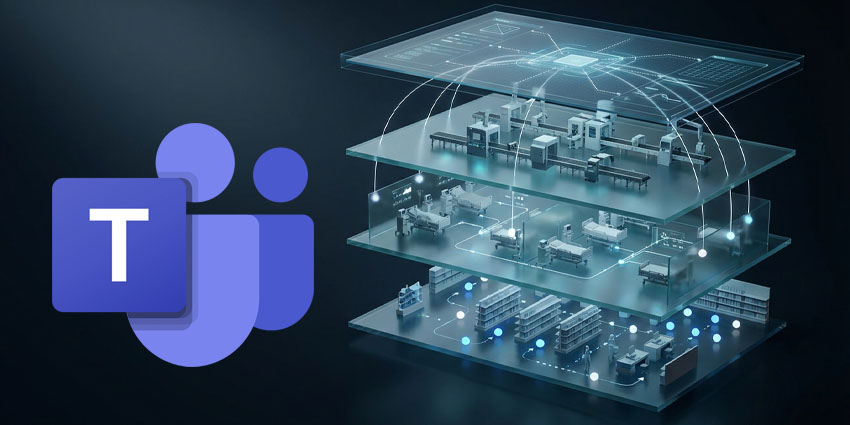One of the great things about working in the communications and technology industry is that life never gets boring.
What’s new today is old tomorrow and you’re never short of new innovations to marvel at as mankind’s reach stretches further and further out into the future.
With this in mind, we’ve decided to poke our heads up into the cloud and pull out six of the most exciting cloud communications trends that 2017 has to offer modern businesses.
1 – Teams
Ten years ago, keeping your team on track and updating them with all the latest business news and objectives used to be confined to an hour or two in the meeting room on a Monday morning alone. Now, however, team collaboration software such as RingCentral Glip, Microsoft Teams and Slack (to name a few) are revolutionising the way modern businesses communicate, keeping users in constant contact with one another and creating a powerful collaborative, remote working environment that allows users to work more productively from any location of their choosing.
When you take into consideration a recent poll which revealed that around 77% of remote workers claimed working off-site drastically improved their overall performance, it’s clear that team collaboration software programmes such as these truly help to underpin a company’s digital transformation (DX) strategies and are a great investment for the future.
2 – UCaaS
Unified Communications as a Service (UCaaS) is a cloud based telephony solution that takes all of your business’s communication services such as voice, web and video conferencing, voicemail, email and chat and hosts them in the cloud which can be accessed at any time and from any compatible device with working Internet access. From a knowledge worker’s perspective, i.e. someone who manages business information and collaborates with an abundance of different users on a daily basis, this is an ideal solution that allows them to stay connected to colleagues and clients around the clock, increases their flexibility and performance and drastically reduces travelling expenses for commuters. From a managerial perspective, according to this PlanetOne Infograph UCaaS cuts down maintenance costs by as much as 51%, improves staff productivity by as much as 60% and delivers a 58% increase in efficiency overall. We must also mention that, as shown in this graph, UCaaS solutions are expected to count for more than half the phone systems in the market by 2020.
3 – CPaaS
In modern business, simplicity is of the utmost importance and success depends heavily on how well a company can communicate with their clients to determine exactly what it is they need and what is the best and most efficient way to deliver it to them. For this reason, the popularity of hosted Communications Platforms as a Service (CPaaS) and the use of APIs (Application Programming Interfaces) amongst software developers who use this coding to modify their company’s phone system or application and make it easier for visitors to navigate through the various functions and extract relevant information with minimal effort, has risen drastically.
With a recent growth report confirming that the CPaaS market is set to rise from $1.5 billion in 2016 to $4.5billion in 2020 it’s clear this is a very popular solution that will soon become a necessity for any modern business looking to stay ahead of the competition.
4 – IoT
, or the Internet of Things, is term that’s highly relevant to the current age we live in where, providing that it has a ‘smart’ prefix, just about everything – from the television sets we watch and the clothing that we wear, to the machines that toast our bread in the morning and the security systems that protect our homes/businesses at night – is (or will be at some point in the future) connected to and controlled by the Internet.
Though it does sound frightfully like the prologue to the Terminator movie franchise, IoT is a clear indication of how the Internet is continuously evolving and is a big part of the digital transformation in both consumer and business settings. It is for this reason a recent survey carried out by a group of senior business leaders claimed that as much as 96% of businesses plan to utilise IoT within the next three years, with 68% having already invested.
5 – Artificial Intelligence
Similarly, like IoT, AI is also having a drastic impact on the performance rates of modern business and is really taking off in a big way with revenues from the AI for enterprise applications market worldwide expected to increase from $357million in 2016 to $31.2billion in 2025.
Though AI technology has already been established in the consumer market with things like Siri and Cortana providing much needed answers to the questions that have been plaguing mankind since the dawn of time (Why am I here? Are we alone in the universe? What time does Tesco close on a Sunday?), advancing voice recognising technology, intelligent machine learning algorithms and chat bots have made AI a smart and powerful tool for improving customer experience online, in app or on call and are especially within a contact centre setting.
6 – WebRTC
A decade ago predictive texting was still considered to be revolutionary, now people mainly communicate for free through apps such as WhatsApp or (more and more frequently) through Web Real Time Communication (WebRTC) protocols such as Facebook Chat that allow users to connect via high quality real time audio/video calling directly from a web browser without even having to download so much as an app.
With a recent research report published by MarketsandMarkets claiming that the WebRTC market is set to reach a value of $1.04 billion by 2017 and on to a whopping $6.49 billion by the end of 2022, it’s clear this is a solution that is quickly growing in popularity and we can expect to see it playing a much more vital role it in business communications over the next five years.
To sum up
As technology continues to evolve, so do people’s expectations, needs and demands. 10 years ago, Apple released their first iPhone with the incredibly profound and highly apt slogan “this is only the beginning” – and when you count how many more they’ve produced and how far the development of the smartphone and the world of communications in general has come since then, you know they weren’t kidding around.
However, if there’s one thing we can be certain of, in the world of business communications technology nothing is permanent and what is revolutionary today will quickly be left behind and replaced a month down the line by something equally new and exciting; and we’ll be there to tell you all about it when it gets here.
About RingCentral
Founded in 2003, RingCentral has since established itself as a globally-recognisable, market-leading manufacturer of cutting edge unified communications and cloud communications based solutions that are changing the way businesses communicate forever more. With flagship products such as RingCentral Glip fast becoming the team collaboration software app of choice for a wide variety of modern businesses, the brand is certainly making big waves in the UC pond and RingCentral you’ll definitely be seeing a lot more of in the years to come.
More on RingCentral on UC Today:
Getting to Know RingCentral – The Disruptive Cloud Comms Provider
RingCentral Q&A: UC Today Meets EMEA Managing Director, Sahil Rekhi
Cloud Communications Versus On-Premises PBX
Making Team Collaboration Apps Successful in Your Business
AI in the Contact Centre – “Is it Really a Reality?”
Can Chatbots Realistically Help my Business?
Exploring the RingCentral Global Platform: Exclusive UC Today Interview







